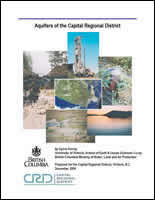Aquifers of the Capital Regional District
 This project, completed in summer 2003 and 2004, focussed on the delineation and classification of developed aquifers within the Capital Regional District of British Columbia (CRD). The goal was to identify and map water-bearing unconsolidated and bedrock aquifers in the region, and to classify the mapped aquifers according to the methodology outlined in the B.C. Aquifer Classification System.
This project, completed in summer 2003 and 2004, focussed on the delineation and classification of developed aquifers within the Capital Regional District of British Columbia (CRD). The goal was to identify and map water-bearing unconsolidated and bedrock aquifers in the region, and to classify the mapped aquifers according to the methodology outlined in the B.C. Aquifer Classification System.
A total of sixteen unconsolidated aquifers and eight bedrock aquifers were identified in this study area (24 aquifers in total). These aquifers ranged in size from < 1 km2 to 538 km2. The majority of aquifers are small (<5 km2) to moderate (5-25 km2) in size, with the exception of the bedrock aquifers.
Unconsolidated sand and gravel, and bedrock aquifers are important water sources in local areas of the CRD. There is thought to be a greater reliance upon wells for domestic water sources in rural to suburban areas of Sooke, Metchosin, Port Renfrew, the Western Communities, District of Highlands and Willis Point. Aquifers on the Saanich Peninsula are also significant sources of water for agricultural irrigation.
The report includes a description of the surficial and bedrock geology of the study area, a summary of the classification for each aquifer, including the level of development, level of vulnerability, aquifer size, lithology, and summary statistics for wells in the aquifer. Also included within the report are hydrogeologic cross-sections and classification maps of aquifers within the Saanich Peninsula, Victoria, Sooke to Metchosin, and Port Renfrew areas.
The report has been broken into 5 separate documents for ease of access. The main report has been formatted to print double sided, with the addition of blank pages.
 Download Adobe Acrobat's PDF Reader for free here. Download Adobe Acrobat's PDF Reader for free here.
This software will enable you to read and print reports that are in "portable document format" (PDF).
Updated: June 2005
|